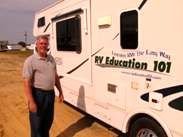I love the freedom of the open road. There is nothing like exploring the back roads in your RV. You can go where you want and when you want in your house on wheels, and because of this often times you find yourself at a new destination everyday. Something many RVers do not take into consideration with this freedom to roam is the weather conditions where you are traveling, or spending the night. RV’s are great, but they are not safe in severe weather, like lightning and thunderstorms with high winds, tornadoes and hurricanes.
When you’re at home you usually know what the weather forecast is by reading the newspaper, listening to the radio or watching television. When you travel hundreds of miles a day in your RV weather conditions can change several times. Many times when you stop for the night all you want to do is get some rest. The weather is the last thing on your mind. The problem with this is severe weather can occur without much warning, and if you are caught in it, it can be disastrous.
So, what do we do, what’s the plan? Plan is the key word here. RVers need to have an emergency weather plan in case of a severe storm. For starters, have you ever heard of the National Oceanic Atmospheric Administration (NOAA) Weather Radio or NWR? The NOAA Weather Radio is a nationwide network of radio stations that broadcast continuous weather information directly from a nearby National Weather Service Office.
They broadcast National Weather Service warnings, watches, forecasts and other hazard information 24 hours a day. Alerts inform people if they need to take some type of action in order to protect them, such as “seeking shelter” or “to evacuate an area immediately!” What does this mean to RVers? It means if you owned a battery operated weather radio receiver you could monitor weather conditions no matter where you are!
With today’s mobile devices, it’s easy to get apps for current weather information or severe weather alerts. This works especially well when you are traveling in your RV. For those who don’t have a smartphone, or for times when you don’t have a strong signal, I suggest purchasing a weather radio receiver. Receivers are available at most retail stores that sell electronic equipment. Prices range from $25 to $200 depending on the quality of the receiver and its features. It is well worth the investment to know what type of weather to expect when traveling or camping in your RV.
We also have a handheld model that we can use when we are away from the campground. It’s perfect for hiking, riding four-wheelers, boating and many other uses. Both models work off of 12 volt DC, 120 volt AC and dry cell batteries. There is also a back-up power system, furnished by built in rechargeable batteries. The rechargeable battery is a secondary power source for emergency use when the battery, 12 volt DC power or 120 volts AC power are not available.
Note: When you are home, you can use the weather radio receiver in your house.
When you arrive at the campground tune the receiver to a local channel that broadcasts continuous weather information directly from a nearby National Weather Service office. Emergency weather watches and warnings are for counties and towns, so always check and know what county or town you are staying in.
If you are using a phone or other device to receive weather alerts, make sure you have a strong signal where you are staying. It’s possible to receive phone calls and text messages but not be able to send or receive data. If you cannot receive data you cannot receive weather alerts.
For more information on the NOAA Weather Radio visit their website at www.nws.noaa.gov/
I am including a short checklist from my Checklist for RVers e-book that you can use to help prepare for emergency weather planning when you are traveling in your RV. You can add to, or take away from this list to tailor it to your specific needs.
The first step to our emergency weather plan is to get a weather radio receiver if you don’t already have one, and to always monitor it when you use your RV.
The next step is to develop an emergency evacuation plan, to use in the event of severe weather. When you arrive at a campground, ask at the check-in desk about an emergency plan in case of a severe storm such as a tornado, a thunderstorm with high winds, or flash flooding. If they don’t have a plan you need to make your own.
Locate a structure that is safer than your RV, like a bathhouse or the campground office. Always stay on the lowest level possible and away from doors and windows.
Brief everybody with you on the emergency plan. Explain to children how to respond to different disasters and the dangers of severe weather, fires, and other emergencies. Instruct children on emergency exits and instruct them on how and when to call 911.
Make sure everybody knows exactly what his or her job is in case of severe weather.
Monitor the weather radio for emergency information. Emergency weather watches and warnings are for counties and towns, so always check a map for the county or town where you are staying.
Have an emergency supply kit made up and easily accessible. The kit should contain: flashlights, batteries, rain ponchos, bug spray, a portable weather radio, first aid kit, non- perishable packaged or canned food, a manual can opener, blankets, prescription and non-prescription drugs, pet supplies, bottled water and any special items for infants, elderly or disabled family members.
To learn more about how to prepare for and react to different types of severe weather take a moment to visit http://www.nws.noaa.gov/.
Remember, RV’s are not safe in severe weather! This includes severe thunderstorms with high winds, tornadoes and hurricanes. Always be prepared for bad weather RVing. Learn about the different types of weather hazards, get a weather radio if you don’t have one, create a plan with your family and practice and maintain the plan. Now go RVing and have some fun.
Happy RV Learning,
Mark Polk
RV Education 101
RV101.tv
RV Orientation
Go for the RV Gold
Follow us on FACEBOOK
RV Consumer
Subscribe to:
Post Comments (Atom)







No comments:
Post a Comment